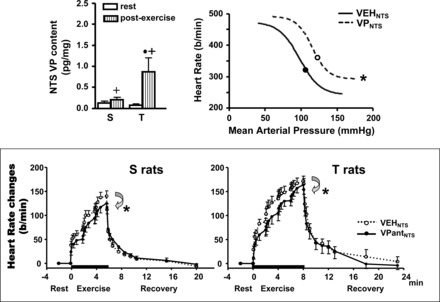Fig. 5.

Graphs depicting the effect of exercise on the activation of descending PVN-NTS vasopressinergic projections [top left: modified from Fig. 4 in Michelini (66)] and the functional responses induced by NTS administration of vasopressin on baroreceptor reflex control of HR [top right: redrawn from data published in Michelini and Bonagamba (67)] and by NTS VP antagonist blockade on HR response during graded exercise on treadmill [bottom: reproduced with permission from Michelini and Stern (69)]. S and T, sedentary and trained groups, respectively; Veh, vehicle; VP, vasopressin; VPant, VP antagonist. The parameters for sigmoidal fitting are as follows: VehNTS: inferior plateau = 242 ± 10 beats/min; range = 232 ± 17 beats/min; blood pressure at half of the HR range = 101 ± 3 mmHg; gain = −3.55 ± 0.45 beats·min−1·mmHg−1; VPNTS: inferior plateau = 293 ± 9 beats/min*; range = 192 ± 15 beats/min*; blood pressure at half of the HR range = 116 ± 2 mmHg*; gain = −4.05 ± 0.48 beats·min−1·mmHg−1. *P < 0.05 vs. Veh treatment; +P < 0.05 vs. rest;·P < 0.05 vs. S group.
